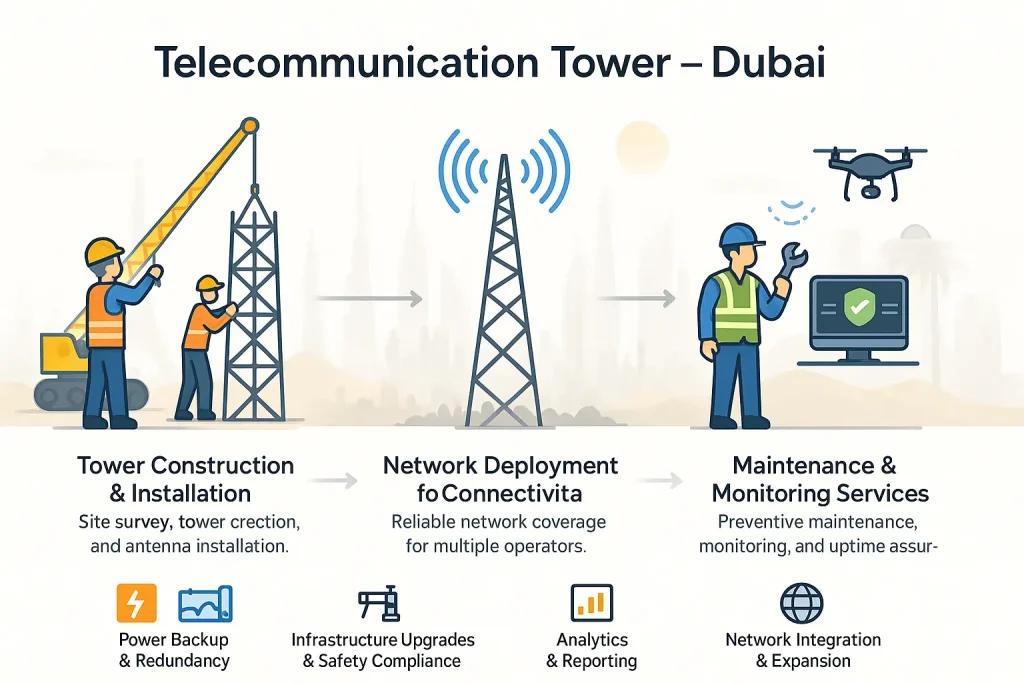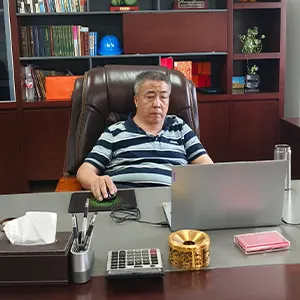Telecommunication Towers in Dubai: Future-Ready Networks
2025-10-25
Telecommunication towers in Dubai are the critical foundation of its future-ready network. As a global hub for business, finance, and tourism, Dubai requires a flawless connectivity experience. The city's ambitious smart city strategy depends entirely on a dense and powerful telecommunications grid. This infrastructure is not just about mobile coverage. It is the physical layer for the Internet of Things (IoT), artificial intelligence, and next-generation services.

This article explores the advanced tower infrastructure of Dubai, the unique challenges of its urban landscape, and its role as a leader in global connectivity.
The Strategic Role of Towers in Dubai's National Vision
Dubai's development is guided by ambitious national plans. These plans position advanced digital infrastructure as a core requirement for economic growth. Telecommunication towers are the enablers of this vision.
Powering the Smart Dubai Initiative
The Smart Dubai initiative aims to make Dubai the happiest and smartest city on Earth. This plan involves integrating technology into all aspects of life. This includes smart traffic management, smart energy grids, and automated public services. These services rely on a massive network of sensors. These sensors must communicate in real time. Telecommunication towers provide the essential 5G connectivity that makes this IoT network possible.
Aligning with "We the UAE 2031"
The "We the UAE 2031" plan sets a clear path for the nation. A key goal is to become one of the top ten countries in the global digital economy. This requires a world-class digital infrastructure. The government has prioritized the development of 5G and future 6G networks. This ensures the country can attract global talent and high-tech industries. The tower network is the backbone of this entire economic strategy.
Enabling Economic Diversification
Dubai has successfully diversified its economy beyond oil. It is now a leader in tourism, real estate, and finance. These sectors all demand high-speed, reliable connectivity. A visitor at a hotel, a trader in the financial center, or a logistics manager at the port all need instant data. A robust tower network ensures this connectivity. It makes the city an efficient and attractive place to do business. This aligns with global principles of regional development, where infrastructure investment drives economic growth.
5G Leadership and Network Densification
Dubai was one of the first cities in the world to launch 5G services. Its operators, e& (formerly Etisalat) and du, have built one of the densest 5G networks globally. This creates unique infrastructure challenges.
The Challenge of a Dense Urban Landscape
Dubai's skyline is famous for its skyscrapers. This vertical environment is very difficult for mobile signals. Traditional macro towers on the ground cannot provide quality coverage inside tall buildings. Mobile signals struggle to penetrate modern construction materials. This requires a specialized approach to network design. The focus is on densification. This means adding more sites to bring the signal closer to the user.
In-Building Solutions (DAS) for Vertical Connectivity
To solve the challenge of skyscrapers, operators deploy In-Building Solutions (IBS). A Distributed Antenna System (DAS) is a network of small antennas. These antennas are installed throughout a building. They are connected to a central signal source. This ensures strong 5G coverage on every floor. These systems are essential for landmarks like the Burj Khalifa. They are also vital for sprawling indoor spaces like The Dubai Mall. Tower providers in Dubai are experts in deploying these complex indoor networks.
The Rise of Smart Poles and Small Cells
On the street level, 5G requires more than just macro towers. To deliver ultra-fast speeds and low latency, the network must be dense. Operators are deploying thousands of small cells. These are low-power base stations. They are often integrated into city infrastructure. Smart poles are a key example. These are streetlights that also contain 5G small cells, Wi-Fi hotspots, and IoT sensors. This approach supports the network. It also supports the city's smart city goals.
Unique Infrastructure: Stealth and Aesthetic Towers
In a city that values stunning architecture, ugly steel towers are not acceptable. Dubai has become a world leader in "stealth" tower design. This involves blending critical infrastructure into the urban landscape.
Blending Technology with Urban Design
Aesthetic integration is a key requirement for network approval. Operators and their partners must design towers that are visually pleasing. This has led to a high degree of innovation. The goal is to hide the tower in plain sight. This ensures the city remains beautiful. It also allows for the dense network it needs.
Palm Tree and Minaret Designs
The most famous stealth solution in Dubai is the palm tree tower. These are monopoles disguised as artificial palm trees. They match the local landscaping. They are very common along highways and in parks. Another common design is the minaret tower. These are placed on or near mosques. They blend perfectly with the traditional architecture. This approach shows a deep respect for cultural aesthetics.
Rooftop Sites and Architectural Integration
Most tower infrastructure in dense areas is on rooftops. New buildings in Dubai are often designed with telecom needs in mind. They have dedicated spaces for antennas and equipment. This integration makes the network less visible. It also ensures that coverage is available from a high vantage point. This is crucial for serving the surrounding streets and buildings.
Key Providers and the Regulatory Landscape
Dubai's telecom sector is guided by strong operators and a clear regulatory body. This creates an efficient and competitive environment.
The Role of Major Operators
The market is led by two main operators: e& (Etisalat) and du. These companies own and manage their extensive networks. They are responsible for the 5G rollout. They compete on network quality, speed, and coverage. This competition drives continuous investment in the latest tower technology. They partner with a range of approved contractors and suppliers to build and maintain their sites.
The TDRA's Guiding Framework
The Telecommunications and Digital Government Regulatory Authority (TDRA) governs the sector. The TDRA is responsible for managing spectrum. It sets the standards for service quality. It also outlines the rules for building infrastructure. The TDRA's pro-innovation policies have been a major reason for Dubai's 5G leadership. The agency works with operators to achieve the nation's digital goals.
Partnering with a Tower Company Near Arabi
Operators in Dubai work with many specialized partners. A skilled tower company near Arabi provides essential services. This includes manufacturing stealth poles. It includes installing complex in-building systems. It also involves performing technical maintenance. These partners must meet very high standards of quality and safety. They are a critical part of the telecom ecosystem.
Dubai as a Global and Regional Telecom Hub
Dubai's network is a benchmark for other nations. Its strategy is part of a wider telecom regional expansion. Comparing its approach to other markets highlights its unique position.
Benchmarking Against Global Cities
Dubai's densification strategy is similar to other global hubs. The challenge of providing 5G in a dense city is shared by 5G tower installation in New York. Both cities rely on a mix of macro towers, rooftop sites, and small cells. Dubai's use of smart poles is a strategy also seen in other smart cities worldwide.
Contrasting with Regional Neighbors
Dubai's network is focused on high-tech urban density. This contrasts with the challenge of scale in its neighbors. Saudi Arabia, for example, is a vast country. Its network requires a massive footprint. This creates a huge need for tower maintenance in Saudi Arabia to cover long distances. Egypt is another key regional market. The 5G launch there is driving demand for a reliable mobile tower provider in Egypt to manage a nationwide upgrade.
Comparisons with High-Growth Asian Markets
The type of challenge in Dubai is different from high-growth Asian markets. The demand for telecommunication towers in India is driven by the need to connect over a billion people. This includes vast rural areas. This is a coverage challenge. Dubai's challenge is capacity. Similarly, the telecom tower installation in Indonesia involves the immense logistical hurdle of connecting thousands of islands.
Parallels with African Mobile-First Economies
Dubai serves as a major data hub for traffic to and from Africa. The connectivity it provides is vital for Africa's mobile-first economies. The push for a 5G tower in Kenya is about building a digital economy. The need for a cell tower near Nigeria is driven by a large, data-hungry population. These nations share Dubai's understanding that mobile infrastructure is key to economic growth. As their networks grow, so does the need for services like cell tower maintenance in Nairobi.
The Challenge of Scale vs. Complexity
Dubai's network may not be the world's largest in land area. It is, however, one of the most complex. This complexity of vertical and indoor coverage is its main challenge. This is different from the challenge of pure scale. For example, communication tower construction in Brazil must cover a continent-sized nation. Dubai's network is a model of technical and architectural excellence.
The Future of Dubai's Tower Infrastructure
Dubai is already looking beyond 5G. The tower infrastructure is being prepared for the next wave of technology.
Paving the Way for 6G
The TDRA and operators are already part of global 6G development. The future 6G network will require even more density. It will likely use higher frequencies. This means the infrastructure of smart poles and small cells will become even more important. Towers will need to be connected with multi-gigabit fiber.
Integrating IoT and AI at the Tower Level
Future towers will be more than just passive structures. They will become active parts of the network edge. Towers and smart poles will host small data centers. This is known as "edge computing." This allows data from IoT devices to be processed locally. It reduces latency. It is essential for applications like autonomous vehicles and remote surgery.
Sustainability and Green Tower Solutions
Energy consumption is a major focus. Powering a dense 5G network requires a lot of electricity. Operators are investing in green energy solutions. This includes using high-efficiency power systems. It involves deploying solar panels at tower sites where possible. Sustainable design is a key part of maintaining a future-ready network. It reduces operational costs and aligns with the UAE's sustainability goals.
Conclusion
Telecommunication towers in Dubai are far more than simple poles. They are a sophisticated, integrated, and essential infrastructure. They are the foundation of the city's smart ambitions and its diversified economy. Through a combination of 5G leadership, advanced in-building solutions, and unique stealth designs, Dubai has built a world-class network. This future-ready grid ensures Dubai will remain a leading global hub for technology, business, and innovation for decades to come.

Hey, I’m Chunjian Shu
"X.Y. Tower: Reliable, innovative solutions for high-quality towers and electrical equipment with professional service.
